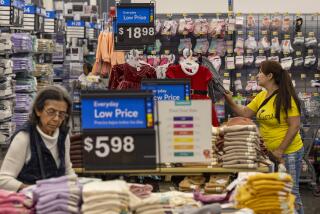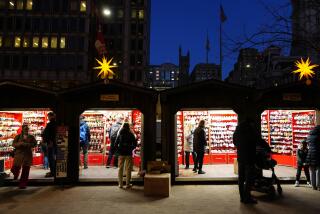This holiday, we spent a record-breaking $850 billion, early numbers show
Santa Claus has come to town. And to your mall. And to your phone, computer, tablet and email.
It’s too soon to fully capture holiday retail sales through the end of the year. But a wave of post-Christmas data put the industry on track to meet record-breaking expectations.
On Wednesday, MasterCard SpendingPulse — which tracks retail spending trends — said holiday sales had seen the strongest growth in the last six years, surging 5.1% to more than $850 billion. Meanwhile, Amazon touted strong sales on millions of Amazon devices, and broad use of the company’s free holiday shipping perks.
“In sales terms, this has definitely been a very strong holiday — one of the best since 1999,” said Neil Saunders, managing director of research firm GlobalData Retail. “Momentum in the consumer economy, confident shoppers and more discipline from retailers have all helped to boost spending.”
Consumers seemed to be merry despite the drop in the stock market, the partial government shutdown and the U.S.-China trade war.
MasterCard SpendingPulse reported on holiday shopping from Nov. 1 through Dec. 24. Cold and wet weather posed some issues during Black Friday and the run-up to Christmas, but shoppers still managed to open their wallets. Apparel saw a growth rate of 7.9% compared with last year, according to the report.
Department stores, though, finished the season with a 1.3% decline from 2017, in part due to store closings. Still, online sales growth for department stores climbed 10.2%.
Amazon reported record-breaking sales of its own. In the United States, more than 1 billion items shipped for free over the holidays with Prime. Even the company’s free two-hour delivery through Prime Now saved shoppers in a pinch: The last Prime Now delivery on Christmas Eve was made at 11:30 p.m. in Berkeley. The shipment included a Lego Super Heroes Captain America Building Kit, a Hallmark card, Greek yogurt and shampoo.
(Amazon founder and chief executive Jeffrey Bezos also owns the Washington Post.)
By the way, if you thought Amazon only tracked your package and shipping data, think again. According to the retail giant, Alexa set more than 100 million timers over the holidays. Eggnog and Moscow Mules were the most-requested drinks on Alexa, and the No. 1 holiday song was Mariah Carey’s “All I Want for Christmas Is You.”
Amazon.com Inc. shares jumped 9.4% on Wednesday. Traditional retailers’ stock prices made big gains too: Nordstrom Inc. climbed 5.8%, Macy’s Inc. jumped 7%, and Kohl’s Corp. soared 10.3%.
Retailers know that to position themselves for strong sales, they have to meet customers wherever the customers are looking to buy, Saunders said. Stores with a strong brick-and-mortar presence along with easy online shopping options hooked shoppers who went searching for each.
Even with the encouraging early sales figures, Saunders said he’s keeping an eye on profit numbers. Retailers are facing a “toxic mix of rising costs,” Saunders said, with higher labor and tariff costs weighing on their bottom lines.
“The main question now is, can retailers keep this performance going as we move into 2019?” Saunders said. “Investors are very nervous about the prospects, which is why retail stocks have taken a bit of a beating.”
The National Retail Federation, an industry trade group, expects sales in November and December to increase from 4.3% to 4.8% over 2017, reaching up to $720.89 billion. That forecast compares with an average annual increase of 3.9% over the last five years. (Labor Day handed the industry a running start: Americans spent a record $2 billion online then alone.)
November retail sales increased 5% over last year, according to the National Retail Federation, putting holiday spending on track to meet the organization’s overall forecast. Strong consumer confidence was one driver, said Katherine Cullen, the group’s director of retail and consumer insights — and, she said, will be important to watch given recent volatility in the stock market.
“Next year, besides the stock market, there are also tariffs,” Cullen said. “There are some things that may start to impact consumer confidence, and we are keeping an eye on that.”
Meanwhile, the volume of online shopping presents a challenge for logistics services such as FedEx Corp. and United Parcel Service Inc. In 2013, a larger-than-expected surge in last-minute online shopping caught UPS off guard. That forced it — as well as Amazon and other retailers — to offer refunds to customers who didn’t receive their orders by Christmas.
This year, UPS said it expected to deliver an average of more than 31 million parcels a day during the holidays and anticipated a peak-season total of about 800 million packages to rise 5% compared with last year’s tally. To deal with the rush of deliveries, the company invested in automation and new facilities to add sorting capacity of 350,000 packages an hour to its U.S. system.
“We’re so far pleased with the operational aspect of it,” said Glenn Zaccara, a spokesman for UPS. “The investments that UPS made in the network, technology, people and planning across the season with our customers obviously paid off.”
The couriers are bracing for a second wave of business as people return gifts. UPS expects return packages to hit 1.3 million on Jan. 3. The company said it had 1.5 million returns, its highest for the season, on Dec. 19.
Siegel writes for the Washington Post. Bloomberg was used in compiling this report.






